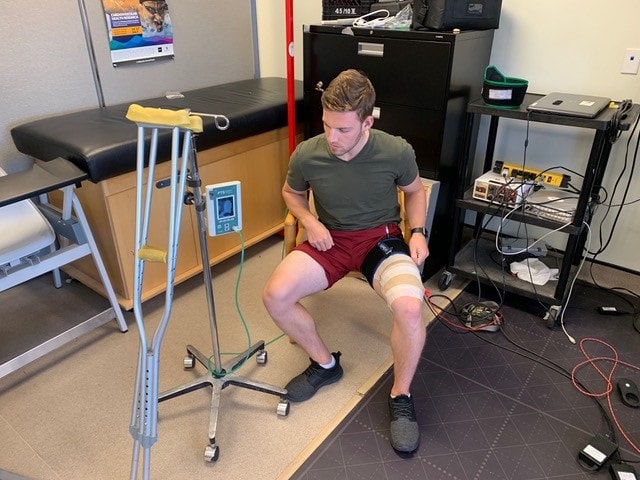No More “Use it or Lose it”: New Discovery May Stave Off Muscle Loss During Post-Injury Recovery
By Leah Turner
17 December 2020

If you’ve ever broken a bone, you may be all too familiar with the loss of muscle that can occur while your limb is in a cast. But there’s good news ahead for the injury-prone among us: researchers in the Human Performance and Health Research Lab in the Department of Human Health and Nutritional Sciences have found a new way to help reduce muscle loss or “atrophy” during recovery.
“Muscles are very much ‘use it or lose it,’” says Prof. Jamie Burr. “It takes as little as two weeks of immobilization to lose a significant amount of muscle mass and strength.”
To date, injury rehabilitation has focused on reversing atrophy through load-bearing exercise after the injury has healed. But this can be challenging for people with chronic mobility issues (such as arthritis), or a serious injury. In fact, for some individuals, rehabilitative exercise is just not possible – and their ability to recover is dramatically reduced.
“The maintenance of muscle mass and strength is essential for maintaining one’s quality of life,” explains Joshua Slysz, a recent PhD graduate and lead author of the study.
Slysz and Burr wanted to see if they could find a way to prevent muscle atrophy during limb immobilization by adapting techniques that are currently used to rehabilitate muscles after atrophy has already set in.
One such technique is blood flow restriction, whereby a low level of pressure is applied to a muscle using a tourniquet similar to a blood pressure cuff. Restricting blood flow during low-intensity training can produce effects similar to those achieved through high-intensity training, and the method has been used to strengthen muscle in people who cannot do high-intensity lifting.
Another current technique is to apply an electrical impulse to the affected muscle, causing it to involuntarily contract. This method is called electrical muscle stimulation. When used alone, the level of stimulation required to be effective is too intense for most patients. But when combined with blood flow restriction, “a very light stimulation intensity suddenly becomes very effective as a training tool,” Burr explains. “To us, combining blood flow restriction and muscle stimulus was a logical next step to determine if we can prevent atrophy in unused muscles.”
But before they could test how well a combined approach could stave off atrophy, the team needed to find 30 volunteers willing to have their left legs immobilized in a leg brace for two weeks.
When asked how difficult it was to find subjects for the study, Burr chuckles. “It was hard to find people that were willing to do it. It took us two years to get enough people through… it was a lot to ask!”
Ten of the volunteers acted as the control group and received neither blood flow restriction nor muscle stimulation treatment. The remaining volunteers received either blood flow restriction alone, or in combination with muscle stimulation twice a day, five days a week.
The researchers discovered that the combination of blood flow restriction and muscle stimulus preserved muscle mass more effectively compared to both the control group and blood flow restriction alone. Although the technique did not prevent a loss of muscle strength, the results offer an exciting development in the field of injury rehabilitation. In fact, the lab is working on a patent for an apparatus that would allow physiotherapists to easily treat their patients using blood flow restriction and muscle stimulation together.
Burr and his team are eager to examine the use of blood flow restriction and muscle stimulation in other applications as well, such as diabetes management. Burr hopes to demonstrate that the approach can help lower high blood sugar in diabetics with reduced mobility, by mimicking the effects of light exercise.
In the meantime, Burr is busy fielding calls from the likes of the Toronto Raptors, the Toronto Maple Leafs, and even an English Premier League soccer team.
“We’re definitely on the radar for sports medicine,” he says with a smile.
This study was funded by the Natural Sciences and Engineering Research Council and the Canada Foundation for Innovation.
Read the full study in the journal Medicine & Science in Sports & Exercise.
Read about other CBS Research Highlights.